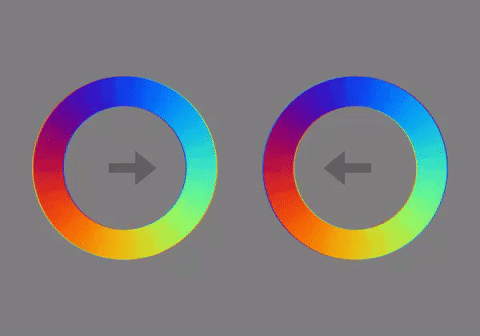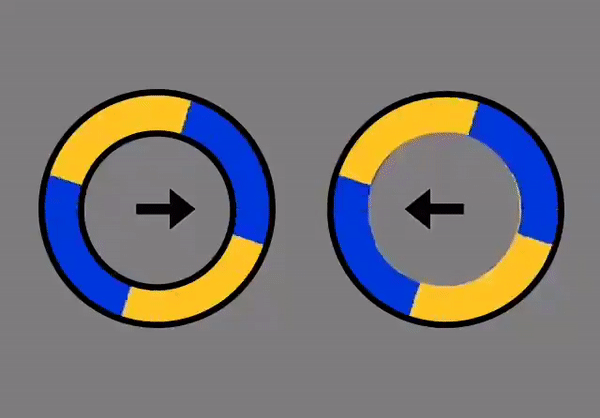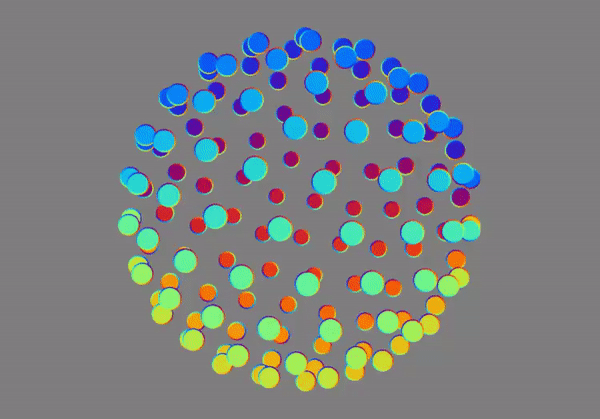Топ-32 оптических иллюзий движения от японского художника @jagarikin

(1)
Есть такой японский цифровой художник じゃがりきん (jagarikin), который экспериментриет с иллюзией движения (обратный фи-феномен), когда пиксели не двигаются, а просто меняют цвет. Его работы репостнули Илон Маск и Стивен Пинкер. За полгода я хорошенько поизучал его работы (отмотал «Твиттер» на 5 лет) и выбрал 32 самых крутых и залипательных. Отметьте для себя, какая иллюзия приковала ваше внимание больше всего, и поделитесь в комментариях.
Канал в Telegram Cognitive Illisions, где я буду делиться самыми вырвиглазными находками, как хакнуть мозг через восприятие.
Осторожно: гифки тяжелые!

(2)
Теория
Фи-феномен — ощущение движения, возникающее при последовательном включении стационарных источников света, а также сама форма этого движения. Характерной особенностью фи-феномена является то, что ощущение движения не зависит ни от цвета, ни от размера, ни от пространственной локализации источников света.

Если интервал включения огоньков менее 60 мс, источники света воспринимаются как горящие одновременно.
Если интервал от 60 до 200 мс, то зажигание лампочек выглядит как непрерывное движение.
Если интервал больше 200 мс, то зритель ощущает, что лампочки загораются одна за другой.
Обратный фи-феномен — это ситуация, когда иллюзия движения достигается благодаря быстрому изменению цвета и контрастности элементов изображения. Все примеры в этом посте — про это.
It is believed that reverse phi illusion is indeed brightness effects, that it occurs when brightness-reversing picture moving across our retina. It can be explained by mechanisms of visual receptive field model, where visual stimuli are summated spatially (a process that is reverse to spatial differentiation). This spacial summation blurs the contour to a small extent, and thus changes the brightness perceived. Four predictions are confirmed from this receptive field model. First, foveal reverse-phi should be broken down when the displacement is greater than the width of foveal receptive fields. Second, reverse phi illusion exists in the peripheral retina for greater displacements than in the fovea, for receptive fields are greater in the peripheral retina. Third, the spacial summation by the receptive fields could be increased by the visual blurring of the reversed phi illusion projected on a screen with defocus lens. Fourth, the amount of reversed phi illusion should be increasing with the decrease of displacement between positive and negative pictures.
Indeed, our visual system processes forward and reversed phi phenomenon in the same way. Our visual system perceives phi phenomenon between individual points of corresponding brightness in successive frames, and phi movement is determined on a local, point-for-point basis mediated by brightness instead of on a global basis.
Neural mechanism underlying sensitivity to reversed phi phenomenon
- T4 and T5 motion detectors cells are necessary and sufficient for reversed phi behavior, and there is no other pathways to produce turning responses for reversed phi motion
- Tangential cells show partial voltage response with the stimulation of reversed phi motion
- Hassenstein-Reichardt detector model
- There is substantial responses for reversed-phi in T4 dendrites, and marginal responses in T5 dendrites

(3)
Иллюзия достигается за счет колец 1-пиксельной толщины по периметру основных колец.
При рассинхронизации вращения «тонких» колец относительно основных и достигается такой эффект.

Предыдущую итерацию обсудили на Хабре в прошлом году. Там есть наглядные описания механизма иллюзии.
Стивен Пинкер восхитился работой художника:

(4)
И じゃがりきん объяснил ему, как работает эта иллюзия:



(5)

(6)

(7)

(8)

(9)

(10)

(11)

(12)

(13)

(14)

(15)

(16)

(17)

(18)

(19)

(20)

(21)

(22)

(23)

(24)

(25)

(26)
Рекламный потенциал

(27)

(28)

(29)

(30)

(31)

(32)
Канал в Telegram Cognitive Illisions, где я буду делиться самыми вырвиглазными находками, как хакнуть мозг через восприятие.
